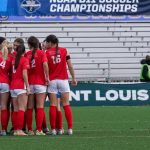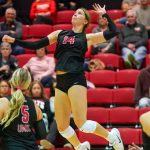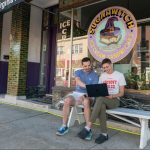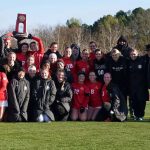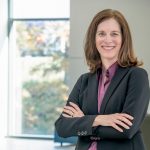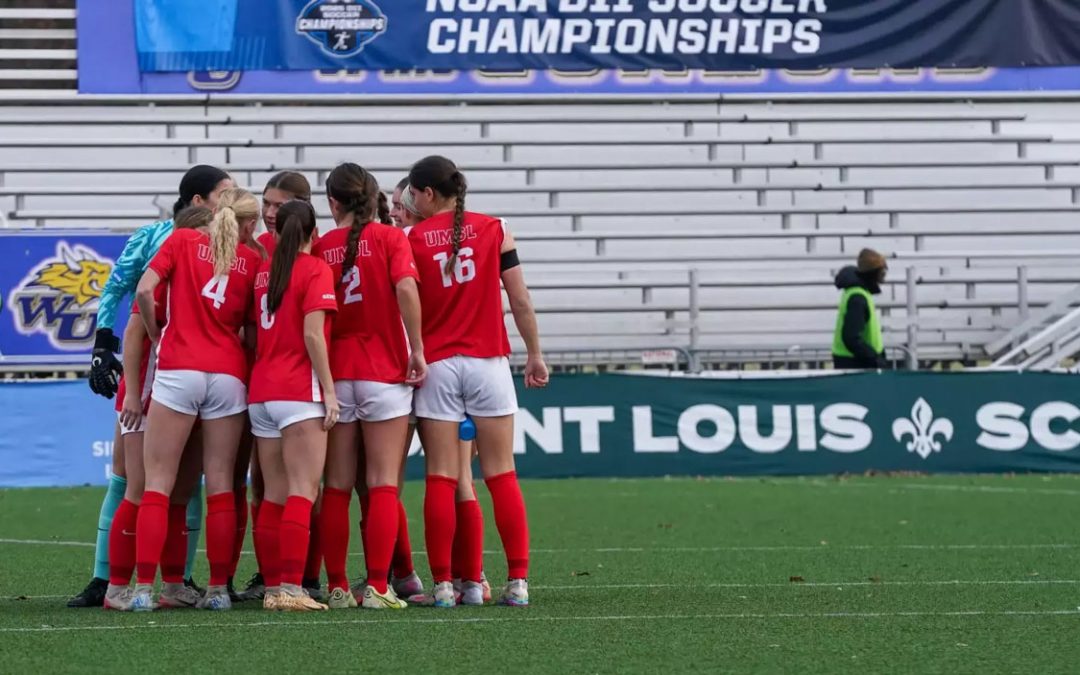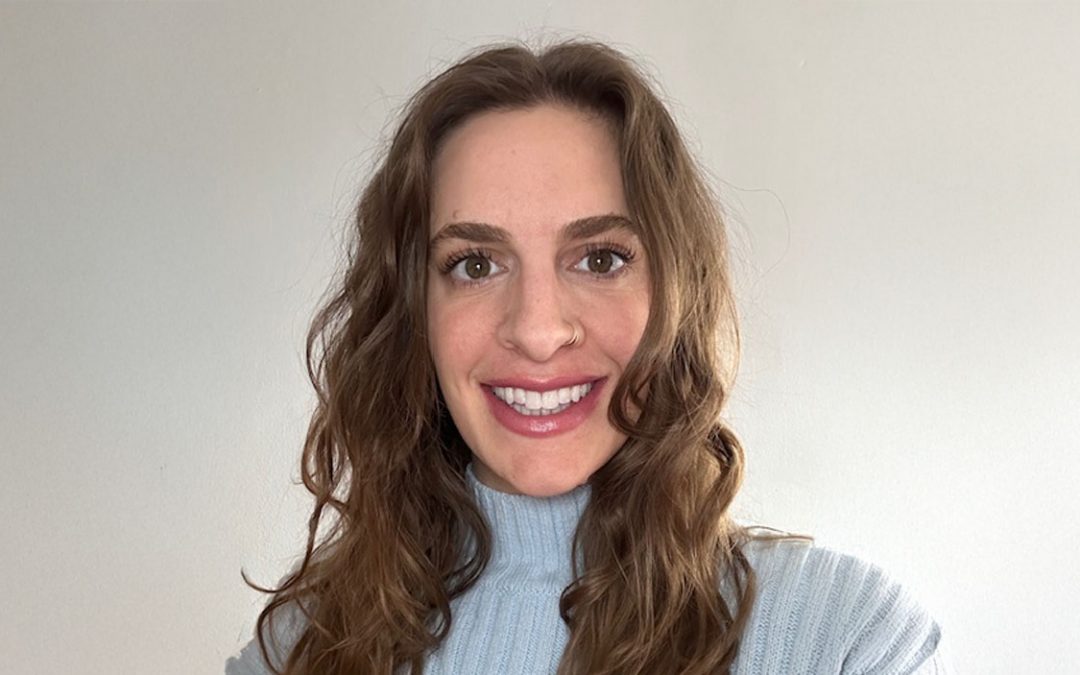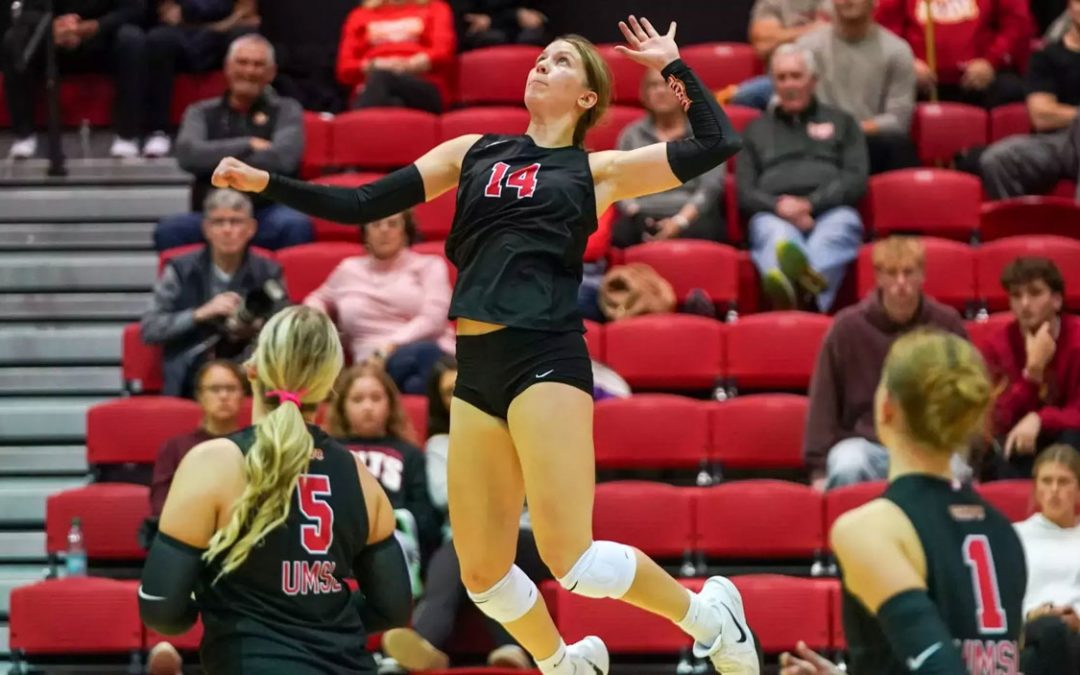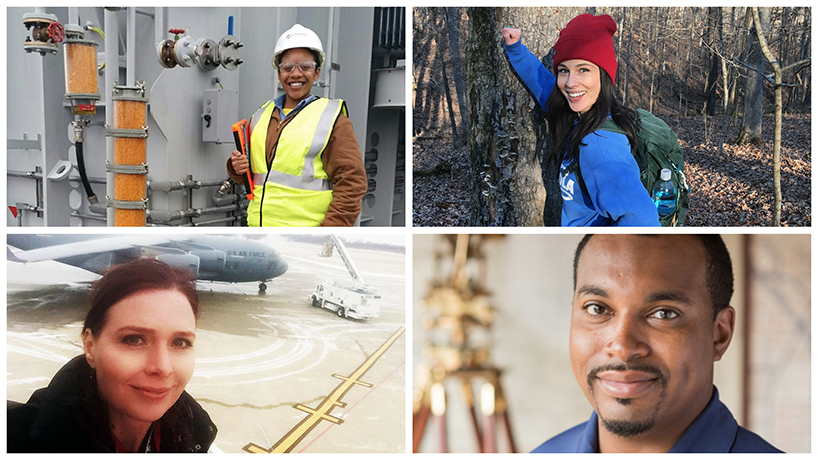
Throughout its 25 years, the joint engineering program has transformed the lives of its graduates and the state of the St. Louis region. Clockwise from top left: Nikia Munson, Jennifer Sommerfeld, Christopher Peoples and Siri Vikan. (Photos courtesy of those pictured)
Metropolitan St. Louis place-bound potential engineering students and regional engineering firms – such as Boeing, Ameren and POWER Engineers – were out of luck.
Locally, there was no low-cost, higher education option, and private-school students tended to relocate after graduation. Then, in 1993, a first-of-its-kind partnership between the University of Missouri–St. Louis and Washington University in St. Louis revolutionized engineering education.
The result was the UMSL/WUSTL Joint Undergraduate Engineering Program, and this academic year marks 25 years of pioneering engineering education. The program will be commemorating the occasion with a celebration at the Blanche M. Touhill Performing Arts Center later this year.
“St. Louis is increasingly a city of tech advancement, and this program plays a large part,” UMSL Chancellor Tom George said. “Thanks to innovative partnerships such as the Ameren Accelerator and the joint engineering program, UMSL students are shaping the future of the region.”
In 2002, the joint engineering program first earned accreditation from the Accreditation Board for Engineering and Technology, Inc. Approximately 400 students are enrolled, and in fall 2018, the program saw 11.7 percent growth.
Joint engineering students study pre-engineering at UMSL and then transition to WUSTL, where they embark on upper-level engineering. Students pay UMSL tuition for their entire course of study and receive their degrees from both schools. In the past two academic years, the program awarded 97 scholarships totaling $230,200.
Though the program was originally formulated to serve nontraditional students, over time, the evening classes, coupled with a growing body of established internship and co-op opportunities, have changed the makeup of the student body. The program now serves just as many traditional four-year students.
The benefits of this model are clear: According to the 2014-15 graduate survey, 95 percent of students graduate with either a job or acceptance into graduate school, and students who interned received a salary offer 20 percent higher than average.
In recognition of the impact that the joint engineering program has had on the lives of its graduates and the St. Louis region, here are four stories demonstrating its transformative power.
Christopher Peoples, BS in civil engineering 2008, president at Pitzman’s Company of Surveyors and Engineers
Staying close to home was important to Christopher Peoples.
After two years in an engineering program at St. Louis Community College–Florissant Valley, Peoples was ready to transfer to a four-year university and, as a young father, felt staying in St. Louis was critical. One of his instructors pointed him to joint engineering, noting that the program made obtaining a WUSTL education affordable.
Peoples was impressed with his professors, most of whom were adjuncts who taught at night and worked in the industry during the day.
“A lot of them used examples of projects that they were working on,” Peoples said. “We were getting viable information. We weren’t just sitting through lectures on theories but learning solutions to real-world problems. I thought that was very important. It also helped me be prepared to walk through the door and say, ‘Hey, I’ve heard of that before. I’ve seen that done before.’”
Peoples took two classes a semester, graduating in a little more than six years. People was discouraged at times, but his advisors helped him realize that the end was in sight and that he would earn his degree. Peoples’ first job out of school was with Frontenac Engineering Group.
“Since I’ve left the program, that company has hired probably, give or take, five people directly out of the program including two that work there now,” Peoples said. “Joint engineering helps provide quality talent to the local businesses, especially some of the smaller engineering firms.”
Peoples pointed out that there’s a looming shortage of engineers due to retiring baby boomers. He sees the UMSL/WUSTL partnership as critical toward filling that gap and wishes that the program had more corporate support.
“This program helps give nontraditional students an affordable option to get a very needed degree,” he said. “I couldn’t imagine the program not existing. It’s a very needed talent pool.”
Nikia Munson, BS in electrical engineering 2011, substation engineer at POWER Engineers
Then-President Nikia Munson was setting up for a Society of Future Engineers meeting and chatting with the day’s speaker, who told Munson about a substation design internship at POWER Engineers.
Munson pounced.
“I know it’s so cliché, but me being involved in clubs definitely helped me grab that internship,” she said. “It turned out to be something that I really love, and that’s where I’m still working now.”
Originally from Chicago, Munson wanted to attend an affordable public university and have a typical college experience. The minute she discovered the joint program, her mind was made up. She had to attend.
Munson has fond memories of late nights studying with her peers. She loved having access to two campuses with two libraries and appreciated the ease of traveling between them on the MetroLink. Plus, there were the professors with their real-world experience.
“I’m still using notes that I took in classes and projects that I did,” she said. “The professors were so spot on with what they required out of us. It was right in line with what an employer would require.”
Like many of her classmates, Munson worked during the day and attended classes in the evenings. She sees the program’s inherent flexibility as transformational.
“So many of my classmates had almost lost hope,” Munson said. “They wanted a new job and knew they had to still support their families. Getting into the program was just a wonder. It opened up so many opportunities for them because they were able to go to school, get a legit engineering degree, find a new job and be able to seamlessly transition without interfering with income. I think that is definitely a game-changer for the St. Louis area. Engineers are just great employees to have.”
Siri Vikan, BS in civil engineering 2013, aviation engineer at WSP USA
If you’ve ever passed time in St. Louis Lambert International Airport’s cellphone lot, you’re familiar with Siri Vikan’s work.
Assigned to develop a St. Louis-region transportation improvement project for her first upper engineering course, Vikan thought, “Lambert.”
“Free engineering,” someone at Lambert thought.
That project got her started in aviation engineering, which became her career. Vikan recently passed the half-year mark working on airports across the country as an aviation engineer at WSP USA following five years at MidAmerica St. Louis Airport.
Engineering is actually Vikan’s second occupation. A mental health professional working in Arizona, Vikan got fed up with the pay ceiling and decided to go back to school to study a hard science.
After two years studying pre-engineering in Arizona, a newly divorced Vikan moved to St. Louis to be close to family and was delighted to discover a program where she could study and work to support herself and her daughter.
While in joint engineering, Vikan worked as a teacher’s assistant, tutored, interned at the Metropolitan St. Louis Sewer District and the Louchmueller Group, and baked wedding cakes. On campus, she was involved with SOFE, Engineers without Borders, Institute of Transport Engineers, Women in Transportation, the Engineers’ Club of St. Louis, Student Advisory Board and the ABET commission.
“I’ve continued to remain as active as possible with the JEP, including the mentoring program, Mentor Collective,” Vikan said. “If it wasn’t for this program and the education I received, I would not have been able to change my life and my daughter’s life to have the freedom and financial freedom to live a much better life.”
Considering her most meaningful moments in the program, she pictures her daughter drawing on the chalkboard next to the instructor. Her daughter was still nursing when Vikan started at UMSL/WUSTL. She appreciates how joint engineering and the instructors welcomed them both with open arms.
“That’s how I got to St. Louis,” Vikan said, “found the joint engineering program, took calc III and lived happily ever after.”
Jennifer Sommerfeld, anticipated BS in mechanical engineering 2019, motion and robotics co-op at Nidec Motor Corporation
Jennifer Sommerfeld wanted to save the world.
“It was a movie that inspired me,” she recalled. “I saw ‘Interstellar’ and wanted to be Matt McConaughey.”
Movies and theater were Sommerfeld’s bread and butter.
After graduating with a BA in English and theatre from the University of Southern California, Sommerfeld was working in publishing in Los Angeles. Wanting a career change, she decided to move home to St. Louis and learned about the joint engineering program from her mother. Fast forward, she’s on track to graduate in the spring.
“It’s changed the way that I think, certainly, and the way I approach problems,” she said. “In engineering, there’s so many different programs you take, so many different courses, so many different specialized topics. I think the common thread throughout these courses is that they teach you, as an engineer, how to solve problems. They don’t strictly have to be technical problems.”
One very direct application of Sommerfeld’s new problem-solving skills is her co-op with Nidec Motor Corporation. Another has been building small machines in shop class.
Coming from a humanities background, she’d initially lacked confidence in her knowledge of basic mechanical tools. But, after working with industrial-sized mills and lathes and learning prototyping, Sommerfeld feels assured in her new knowledge.
“You get to create things, and that’s why a lot of people are drawn to mechanical engineering in the first place,” she said. “This program attracts people from every stage in life, every background. It gives them encouragement and confidence to go after a really important degree and better themselves and try to follow their passions. It makes it possible to go to school and support yourself, support your family, and that’s a very rare thing.”


